A wonderful thing about fantasy role-playing games is that they unfold mainly in the minds of the players. They are games of wonder and imagination. Players that keep this concept firmly in mind realize that they can play almost anywhere. Over the years, I’ve played AD&D (my game of choice) in basements, in dining rooms, in living rooms, and in a bedroom (sixth-grade sleepover). We’ve sat on floors, folding chairs and bar stools. We reclined on couches and played poolside on lounge chairs. To a limited extent, we once played in a car and while walking through a park. Your environment can be minimal, if necessary. A few sheets of paper, a pen, and some dice are all that is really needed (and even the dice are questionable). Nevertheless, a nice gaming area can indeed make the game session much more comfortable, more efficient, and more intense.
I have been blessed in that I have been able to play RPGs for over 25 years now, and I’m currently blessed with a comfortable home in which to play. Over the last few years, I decided to make small, incremental improvements to our area. Why not, especially if gaming is a consistent hobby? I am quite pleased with the results so far, but I’m always looking for small ways to improve further. Inspired by an article by Johnn Four of Roleplaying Tips, I recently took stock of all my gaming area features, and I share my thoughts with you now. Perhaps an idea that I borrowed along the way might prove useful to your group. I would love any tips or suggestions that you might have.
A Good Table
The best shape is highly debatable and likely a matter of taste. Space requirements and cost are also important factors. However, almost everyone agrees that having a table is key to a good game. It allows players to connect with one another, and it builds intensity. Granted, I would game on the floor if I had to, but getting a good table is worth the effort.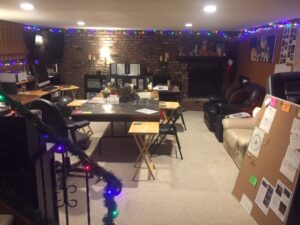
My friend used to host our games for many years, but he eventually passed away. His brother asked if I would take the table and continue the tradition, and I accepted. The table was one that he had made from a sheet of 4′ x 8′ plywood. He slapped some sort of fiberboard over it. He then nailed 3″-wide strips of pine on all sides to give it some depth. On the underside, he attached the folding legs from a folding table. Thus, while a bit large and bulky, it does fold up. Initially, I wasn’t sure that I wanted this thing set up permanently in my basement so being able to take it down quickly helped to convince the wife to allow it. Once I set it up, I decided to spend 20 minutes to stain the sidepieces a walnut color. I also had strips of molding that were unused so I nailed them on and stained them as well. These were just minor touches, of course, but you no longer see unpainted lumber. As for size, we could fit seven players and a DM without a problem. As it is a bit wide, I opt to store a bunch of terrain and other stuff in the middle toward the DM screen. It makes for easy access, and it adds some atmosphere too.
Bookcases and Magazine Holders
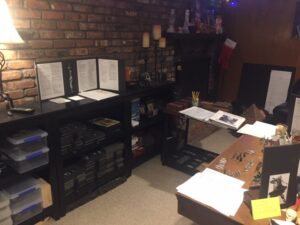 Having easy access to many gaming books is obviously a bonus. My den, where we play, had some built-in shelves, which I used in the early days. However, after the wife warmed to the idea of the den being a gaming room, she suggested sprucing it up a bit. She found a mildly inexpensive, two-shelf, black, wooden bookcase from Target. As we had just received a nice tax return, I ordered seven of them. They now line the walls in certain areas. The ones behind the DM hold my figures, some terrain, and spare dice, while some nice candle holders, a lamp, and some knickknacks adorn the tops. Another case holds all of my RPG rulebooks and modules.
Having easy access to many gaming books is obviously a bonus. My den, where we play, had some built-in shelves, which I used in the early days. However, after the wife warmed to the idea of the den being a gaming room, she suggested sprucing it up a bit. She found a mildly inexpensive, two-shelf, black, wooden bookcase from Target. As we had just received a nice tax return, I ordered seven of them. They now line the walls in certain areas. The ones behind the DM hold my figures, some terrain, and spare dice, while some nice candle holders, a lamp, and some knickknacks adorn the tops. Another case holds all of my RPG rulebooks and modules.
Atop two of the cases, I placed some decent looking magazine cases that I bought at Staples. Though only black faux leather, they do keep things looking neat and on the nicer side.
Side Tables
A friend gave us a spare wooden kitchen table. It’s somewhat small, and we don’t use it in the kitchen, but we didn’t want to throw it out. Thus, it now sits against one wall and is quite useful. I keep my portable LED tracing ‘table’/pad on it (not used during the game, but very handy to have out during game prep), along with other knickknacks. I also have another lamp on it. You can never have too much table space (or light).
I keep a smaller wooden table near the traditional DM spot at the head of the table. I keep more figures on it, along with several other props and a few binders.
Computer
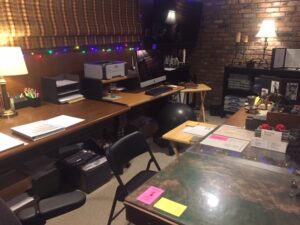 I have no laptop, though that would be ideal, I guess. Instead, I have my iMac on an old computer table near the DM-side of the table. Though initially I used this only during game prep, I have come to use it more and more during play. I like having various audio files and soundtracks ready to play, and having the iMac within reach makes that easy. Also, I now keep several relevant documents open for easy reference. Furthermore, if the players catch me completely off-guard, it usually only takes me a minute to pull up the needed information from some other document on my hard drive.
I have no laptop, though that would be ideal, I guess. Instead, I have my iMac on an old computer table near the DM-side of the table. Though initially I used this only during game prep, I have come to use it more and more during play. I like having various audio files and soundtracks ready to play, and having the iMac within reach makes that easy. Also, I now keep several relevant documents open for easy reference. Furthermore, if the players catch me completely off-guard, it usually only takes me a minute to pull up the needed information from some other document on my hard drive.
A Brother laser printer sits on the same computer table, making it extremely convenient for game prep. It also makes it very easy to print a document during play if they need it.
Leather Armchairs
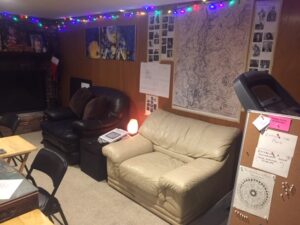 The den was a den before it was a gaming room so we have two old leather armchairs in there. Rather than get rid of them (we have no other place to put them, and we kind of like them), we put them up against a wall. When our smaller groups play, no one sits in them, though they do offer a nice break for anyone whose butt hurts or who wants a change of pace. In our larger group, one person usually sits in one, though he gets up during battles.
The den was a den before it was a gaming room so we have two old leather armchairs in there. Rather than get rid of them (we have no other place to put them, and we kind of like them), we put them up against a wall. When our smaller groups play, no one sits in them, though they do offer a nice break for anyone whose butt hurts or who wants a change of pace. In our larger group, one person usually sits in one, though he gets up during battles.
Terrain
I have very mixed feelings on terrain, though you wouldn’t know that from the amount that I have. I do love the atmosphere it brings, and it does make envisioning certain things much easier. However, I do not like having several rooms set up for each session (as many are wont to do when you have so much of it—and as pictured on Dwarven Forge’s website for obvious reasons). I’ve found that a pre-made layout ends up dictating the session instead of being a useful prop. No. We use terrain in almost every game, but it is always in a form that we can throw together and take apart very quickly. We’ll make a room or two at a time, as we go. This is why I opt to keep most of the terrain right on the table. The types of terrain pieces that we keep on the gaming table are those that we use often: about 50+ stone dungeon floor tiles (10′ x 10′), many stone dungeon wall tiles, some curved stone dungeon wall tiles, some cavern floor tiles, cavern wall tiles, cavern outcroppings, boulders (small and large), tree stumps, fallen trees, small trees, and large trees (lots of trees).
Other types of terrain that I keep in the bookcases include all kinds of treasures, furniture, boxes, crates, barrels, stone columns, campfires, etc. Actually, many of these things are so cheap and get so much use that I highly recommend picking them up. Unlike the Dwarven Forge sets (which are beautiful, but quite pricey), you can get these miscellaneous items rather cheaply. I prefer Legendary Realms for this small stuff (they have a store by me, but they are also on eBay, I believe).
At some point, I grew tired of putting back and then pulling out the same small pieces each session. I found a common plastic bin (maybe 6″ x 12″) and threw these small pieces in it. When we need those pieces, I just grab the bin from the bookcase.
Gaming Mats And Plexiglas
We have used several different types of vinyl wet-erase mats over the years (Chessex battle mats, for example), and we’ve also gone without a mat. I eventually decided that drawing a map on a mat was more trouble than it is worth. I hate to take game time to draw with any accuracy, while very poorly done maps cause more confusion than clarity. Also, the wet-erase markers never quite work perfectly so after a while you can see old drawings on the ‘clean’ mats, which stinks. There are also different types of vinyl maps; some are plain (often cream color), while others are gray and look like stone, and others are green to resemble a forest. Which to use?
I eventually settled on a large (48″ x 48″) green forest mat, which makes setting up a forest encounter extremely easy. With our vinyl mat permanently laid out, we just grab a handful of trees and boulders and scatter them about. When we want to make dungeons or caverns, we just grab the stone tiles and place them over the green mat (which soon disappears beneath them).
Plexiglas is an old gamer’s trick to keep those Avalon Hill-style folded maps pressed down flat so your cardboard unit counters don’t slide. I eventually obtained two small pieces for my table. They do not cover the whole thing (no need), but together they cover about half the table—the part where we have the mats and where we throw together dungeon tiles. This protects the mats and gives you a nice, hard, flat surface for figures.
The Plexiglas gives an added bonus too. There is usually some room around the perimeter, where we would not usually set up tiles or have figures. In those spots, I lift up the Plexiglas and throw some paper props underneath, like the menu to the local tavern, the prices at the local trading post, an index card of Varangian runes (so those PCs that ‘know’ the runes can just peer down to recall what they know), and an index card with the phases of the AD&D combat round (for newbies that may get confused).
Player Chairs and Snack Tables
We use black folding chairs, but they have padding on them, which makes them bearable. Again, players can always get up and sit in the two armchairs nearby if they want a break. I also have my computer chair for a player that doesn’t want to deal with folding chairs.
Though it’s unreasonable to ask players not to put stuff on the table, it is a secret pet peeve of mine because we lose so much space for props and figures. To mitigate the encroachment, I set up snack tables with coasters between every two chairs. For a touch of class, I have gargoyle coasters from Paris and square marble coasters from upstate NY.
Card Table of Snacks
On the other side of the den, about 10′ from the table, is a small card table with assorted snacks, drinks, and paper goods. My players are very comfortable in helping themselves to anything on the table. I usually provide some staples (pretzels, soda, flavored water, and iced tea), while each player often brings a small something. A 30-gallon, black, garbage bag is kept open over there, and it makes cleaning up afterwards a snap.
Cork-board
About two years ago, one group of players spent so much time arguing among themselves over priorities that they confused themselves and lost track of their objectives. Not great game-play, for sure. Though I believe in natural consequences, I did not want this tendency to ruin the game. Thus, I purchased a 35″ x 46″ cork-board, some push pins, and a stack of index cards. I taped a Sharpie to the top. I stash the board out of sight until game time, and then I just lean it against the treadmill, or wherever they want it. It definitely helped. My other groups do not need this so it remains out of sight.
Walls
Huh? Our den has old wooden paneling from the 1970s or 1980s. Not our cup of tea, but changing that is like #412 on our to-do list. How to make use of the paneled walls without ruining them? Masking tape. My current campaigns center on a large lake. A friend used a plotter at work to print an enlarged copy of the map. At his suggestion, I then taped it to the wall for the players to see. It’s great. It really draws players into the game. Everyone can see basics from the table, but anyone can also walk over and point out details. I do want to get a laser pointer so I don’t need to push past seated players to get to the map.
While thinking of the paneled walls as a giant bulletin board, I also printed out another fun prop and taped that to the wall. What was it? I asked every player to tell me which famous Hollywood actor would play each of his or her PCs. Then I found a good picture of each celebrity, dropped each into a Word doc, and labeled everyone. Now each party has a visual of all the other PCs in the party.
The best part about all this is that I can pull the stuff off the wall in about five minutes, if the need arises.
Custom DM Screen
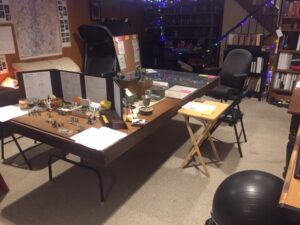 Back when we were playing 3E, I wanted a custom DM screen for the many house rules that we had created. A friend suggested those black, foam, tri-fold, presentation boards, which you can pick up at Staples. I cut it down a bit. It’s 12″ high and has three sections. The center section is 24″ wide, and each of the two wings is 12″ wide. That’s a good-sized DM screen. I then printed out some great pictures, cut them out, and then used rubber cement to fix them to the players’ side of the presentation board. I then printed out my custom tables and affixed those to the DM side. I was quite happy with it and used it for many years. When we switched to AD&D, I made a new one for that.
Back when we were playing 3E, I wanted a custom DM screen for the many house rules that we had created. A friend suggested those black, foam, tri-fold, presentation boards, which you can pick up at Staples. I cut it down a bit. It’s 12″ high and has three sections. The center section is 24″ wide, and each of the two wings is 12″ wide. That’s a good-sized DM screen. I then printed out some great pictures, cut them out, and then used rubber cement to fix them to the players’ side of the presentation board. I then printed out my custom tables and affixed those to the DM side. I was quite happy with it and used it for many years. When we switched to AD&D, I made a new one for that.
Ironically, I no longer use it much, though it still sits in place near one head of the table. I seldom reference it, but it does serve to wall off some of my notes, my figures that I pulled out for use during the session, a stash of pencils, specialty dice, etc.
Extra DM Seat
Initially, as DM, I sat at the head of the table (very traditional). However, I disliked being so far away from the figures on the table, and I found myself having to get up constantly. As we have groups of three-five players on average, there is usually some extra room at the table. Thus, I took to sitting in one seat that would be next to the DM. Behind that spot, facing away from the gaming table, is the computer and printer. Thus, from that spot, I can access the computer, still slide into the traditional DM spot at the head of the table, and more easily get to the map and the figures on the table. As stupid as this may sound, I also find that it lessens the poisonous ‘players v. DM’ mentality. In that spot, I keep a cute dice tower and my DM dice for the night, as well as my index cards that I use to keep track of initiative. In that spot, I also keep an 8.5″ x 11″ piece of cardboard, with ten boxes drawn on it–one for each segment in a combat round. I place small chits on the boxes to note when the party and when the monsters go in a given round.
For a DM chair, I use a Gaiam rolling ball chair, which is comfortable and easy to kick out of the way, when I need to get up (which is still often).
Ambiance
Candles are fun—that is until you cannot see or until you get eyestrain. As much as I would love some sort of fancy lighting, getting my electrician to put in dimmer switches for the high hats is not in the cards at the moment. However, as the den has taken on a rather clubhouse feel, I hung three strings of small Christmas lights around the room, where the wall meets the ceiling (small finishing nails hold them up). I throw them on this time of year, or whenever I want to smile (they make me happy). Subconsciously, they add a warm, cozy feeling to the room.
I also have a few scented candles around the room, and though we don’t play by candlelight, I sometimes light the candles for fun. I also have a few battery-operated candles that look pretty realistic (I think Luminara is the expensive company that makes them, but there are cheaper ones on Amazon).
Memorial Cup
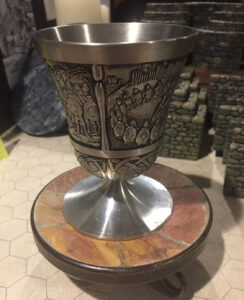
In memory of Doug Smestad and Mike Foster.
So there you have it. That’s our gaming area. Not long ago, a young solar panel technician came to the house to measure something, and when he walked downstairs and passed the den, he stopped in his tracks and said, “Whoa! What a setup!” He actually caught me off guard because I never really think of our setup as anything extraordinary. We have no mini-fridges, no projectors dropping down out of the ceiling, no mood lighting, etc. Yet, I guess when you improve things bit-by-bit, you don’t notice how far you’ve come. So I leave you with this challenge: Find one small way to improve your area as this year comes to a close. It need not be expensive. You needn’t spend money at all. Maybe it’s just how you arrange the furniture. Maybe it’s repurposing an old table that is gathering dust. Be creative. Better yet, ask your players to help. Ask them to make suggestions. They might even donate some doodads or toys to your area. I certainly inherited some features of mine. Great stories and the accompanying memories certainly make playing groups tighter, but so does a shared space. It’s your clubhouse. Make the most of it and have fun doing it.
